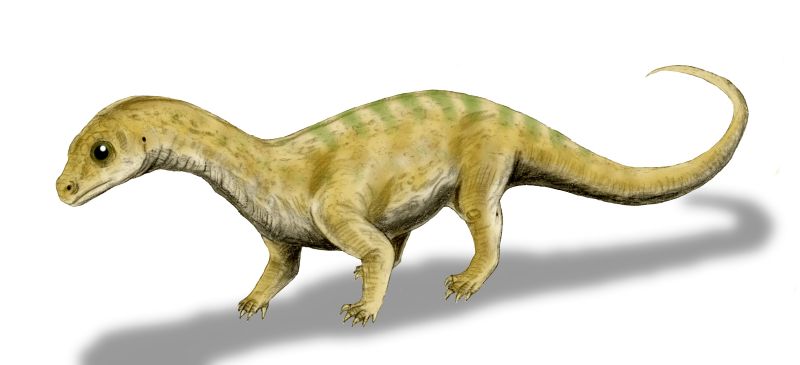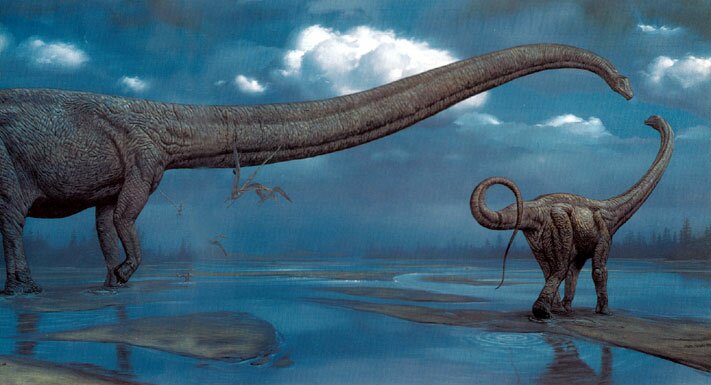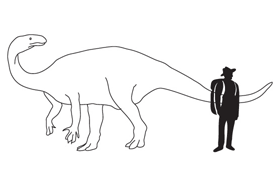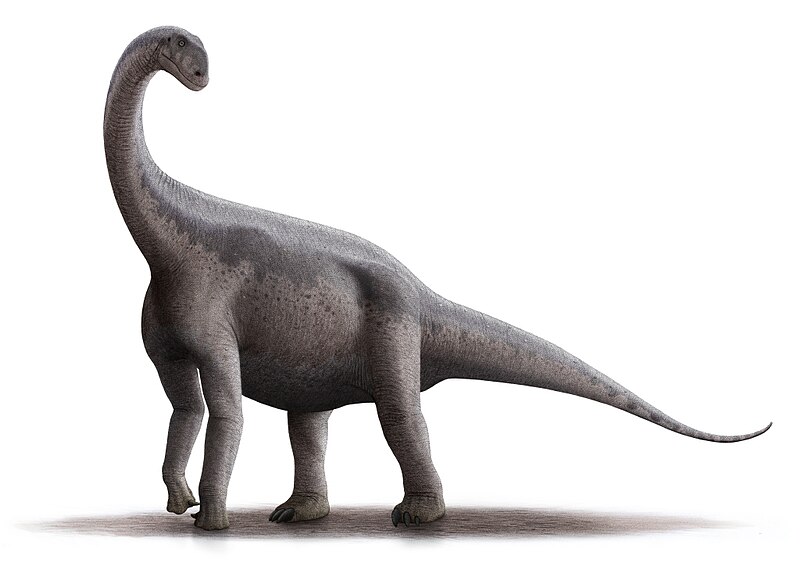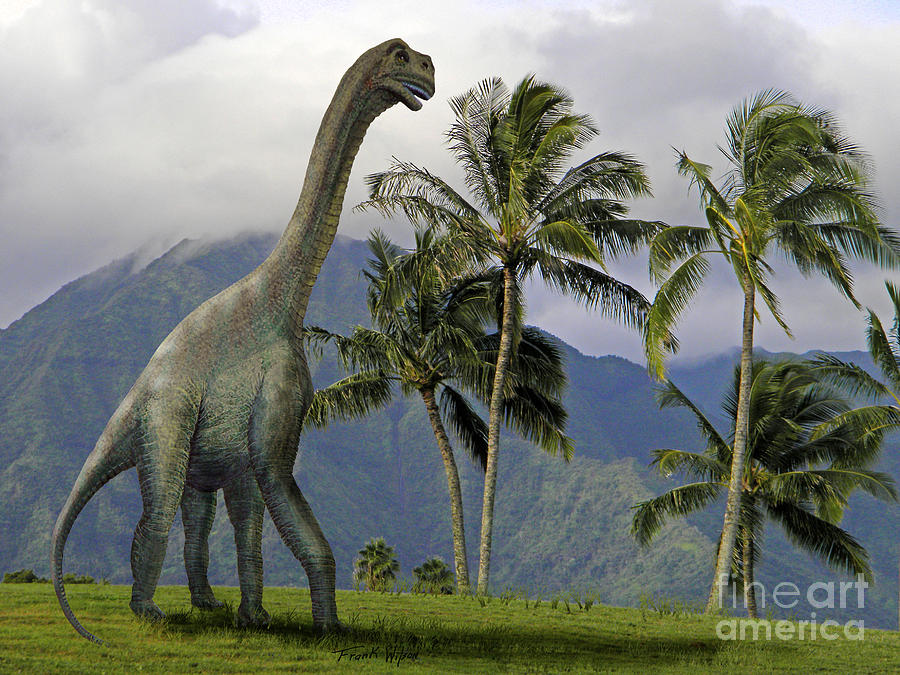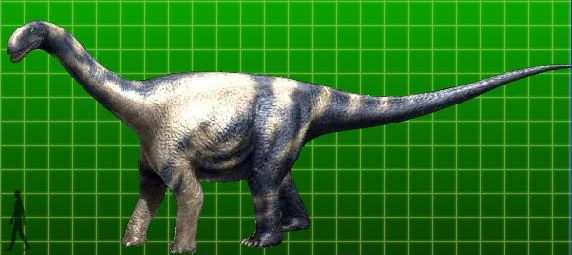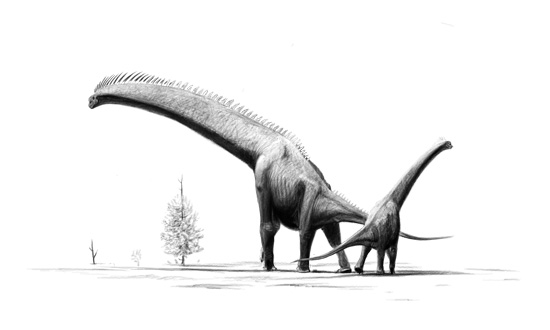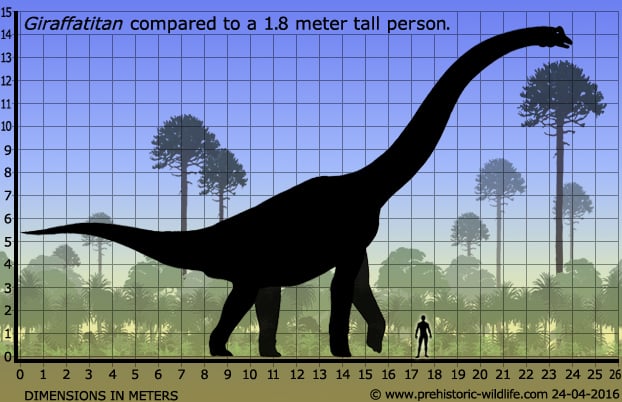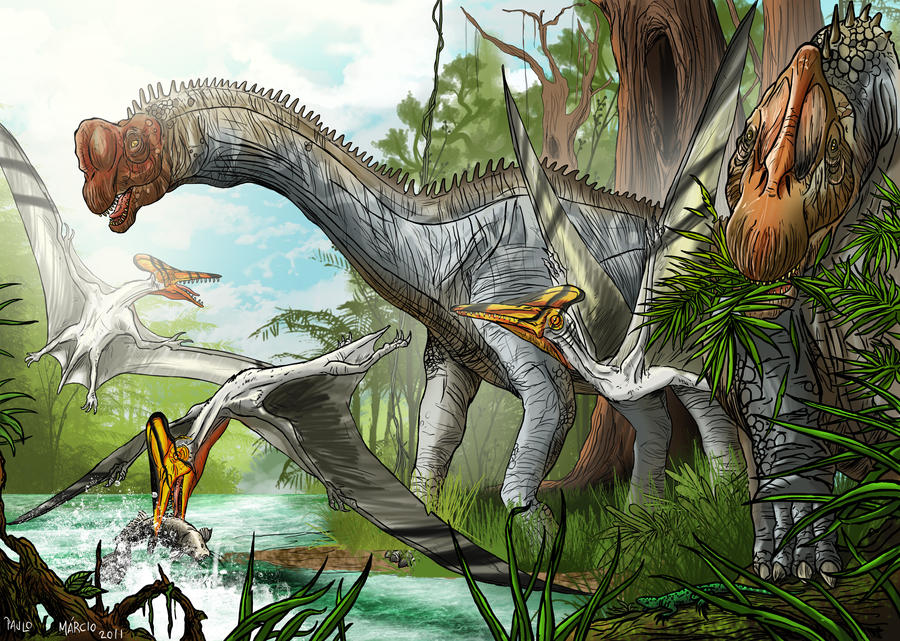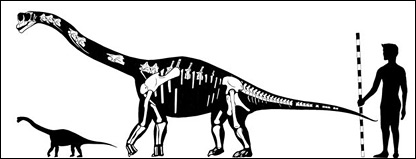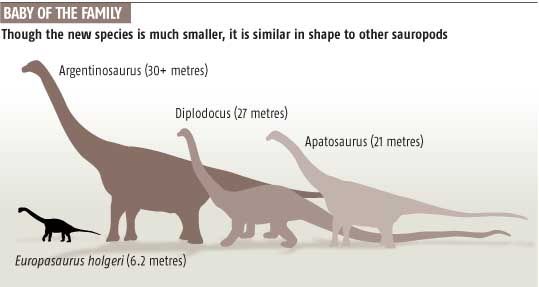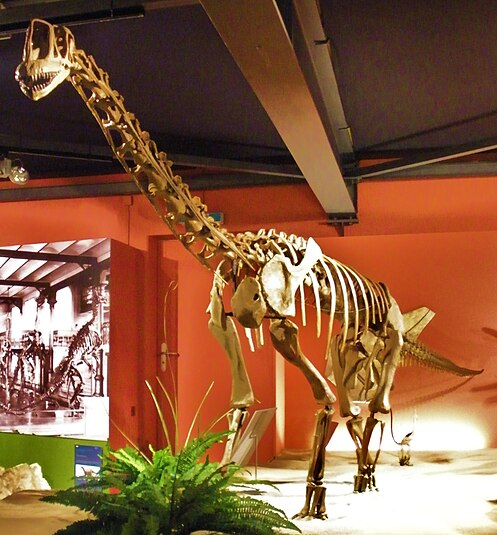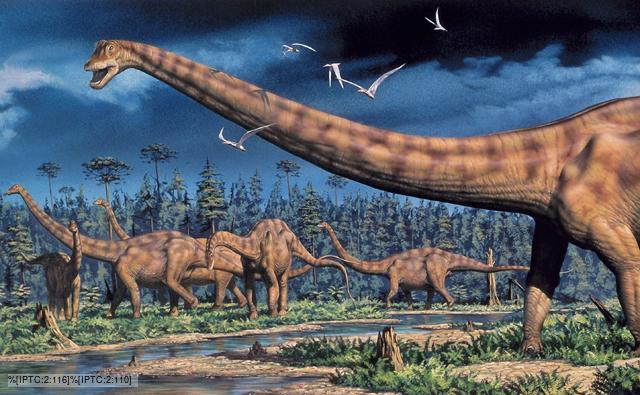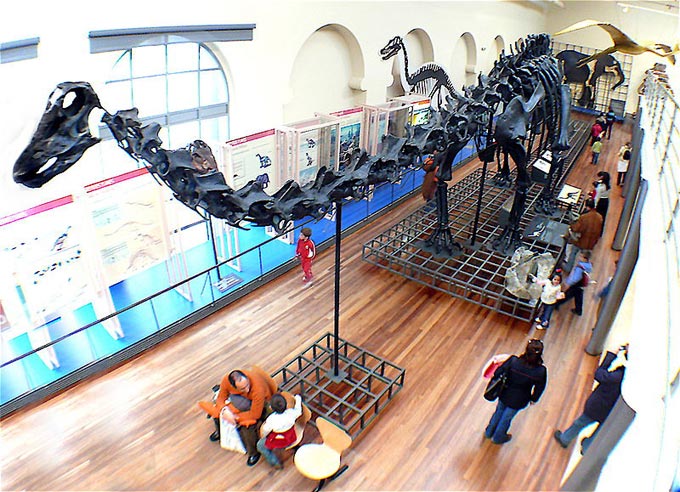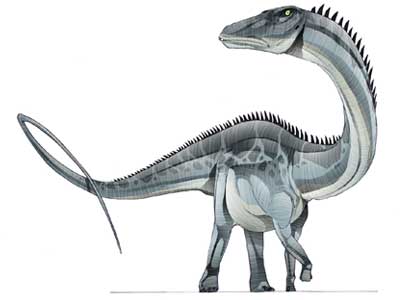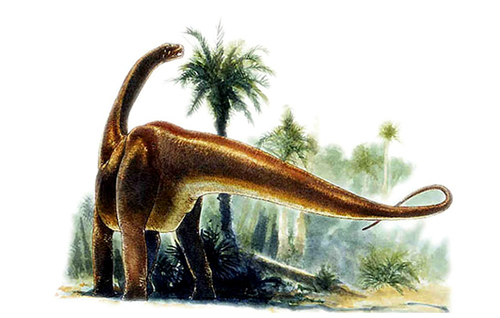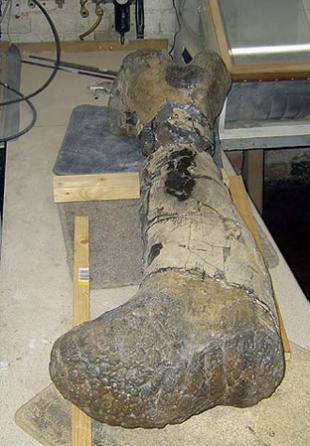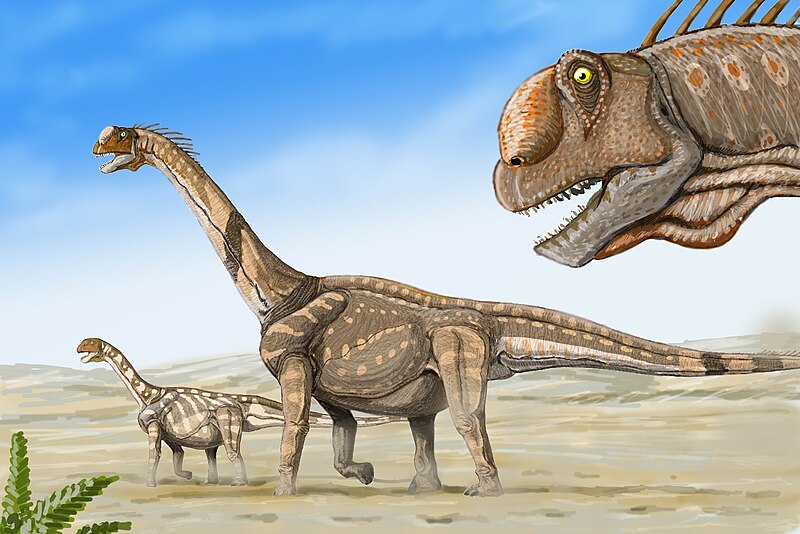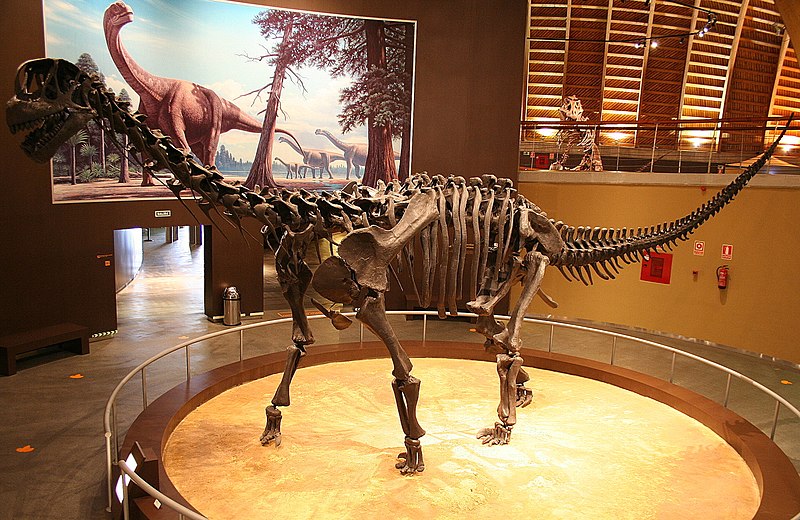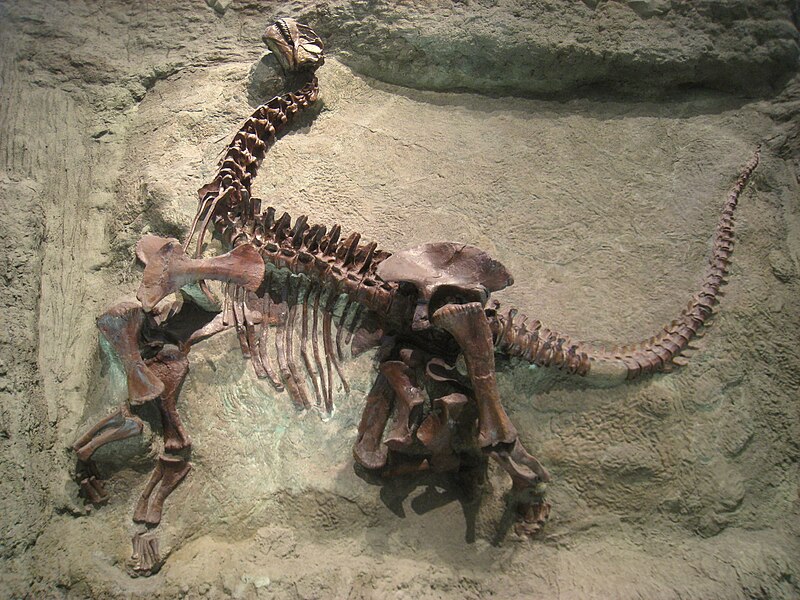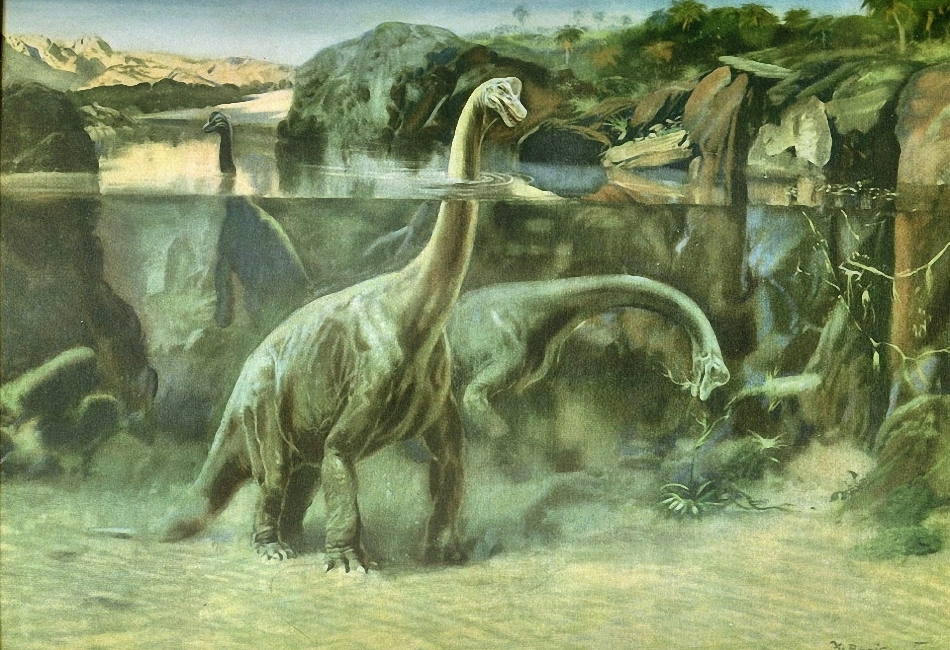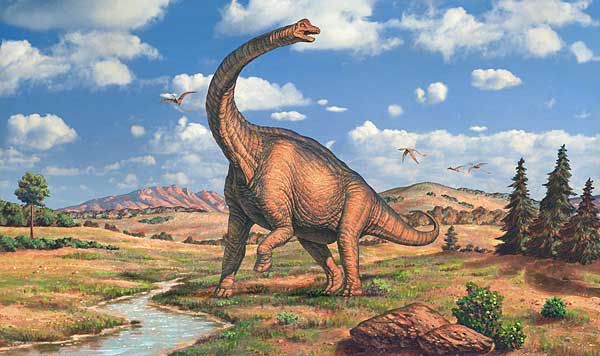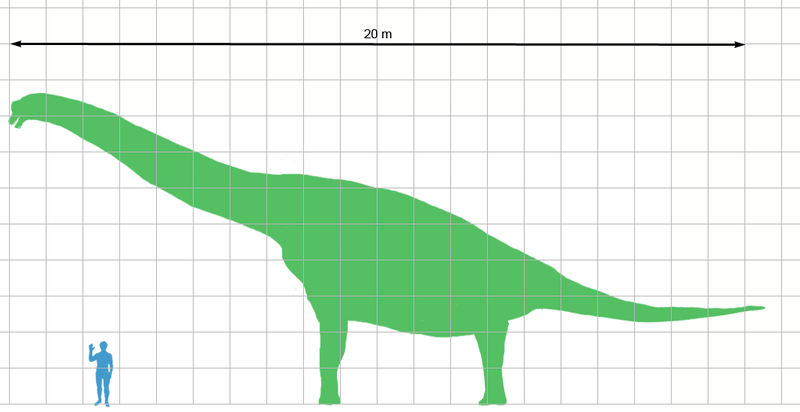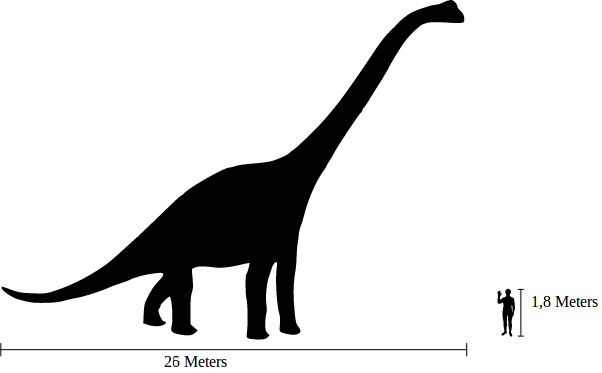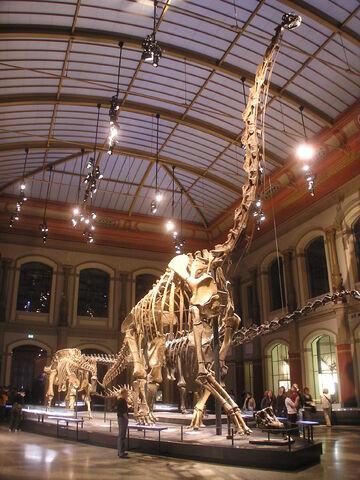[Recent Entries][Archive][Friends][User Info]
Below are 20 entries, after skipping 20 most recent ones in the "Сообщество, посвящённое ра" journal:[<< Previous 20 entries -- Next 20 entries >>]
| November 6th, 2012 | |
|---|---|
| 06:13 pm [industrialterro] [Link] |
Massospondylus Массоспондил, или Массоспондилус (Massospondylus) — растительноядный динозавр раннего юрского периода (от 200 до 183 миллионов лет назад), один из самых древних динозавров. Название происходит от греческого μάσσων (massōn, «длинный») и σπόνδυλος (spondylos, «позвонок»). Был описан в 1854 году сэром Ричардом Оуэном по останкам, найденным в Южной Африке и является одним из первых динозавров, получивших название. Ископаемые останки были обнаружены также в Лесото, Зимбабве, Намибии, в ЮАР, США и Индии. Массоспондилы имели длинные шею и хвост, взрослые особи достигали в длину 5 метров. Во взрослом возрасте массоспондилы могли ходить на задних ногах, используя передние лапы с большим когтем на каждой для защиты и захвата листьев, употребляемых в пищу. Для добывания пищи с верхушек деревьев служила и длинная шея. Детёныши массоспондилов передвигались на четырёх ногах. Согласно современным исследованиям, после рождения они ещё не были способны добывать пищу, в связи с чем об этом должны были заботиться взрослые особи. M. kaalae Barrett, 2009 — вид, живший в юрском периоде окоо 199—189 млн лет назад. Описан в 2009 году на основе частичного черепа. Ископаемые останки были найдены в местности Voyizane в формации Upper Elliot на территории Южной Африки; M. rawesi. The type species is M. carinatus; seven other species have been named during the past 150 years, but only M. kallae among these is still considered valid. Prosauropod systematics have undergone numerous revisions during the last several years, and many scientists disagree where exactly Massospondylus lies on the dinosaur evolutionary tree. The family name Massospondylidae was once coined for the genus, but because knowledge of prosauropod relationships is in a state of flux, it is unclear which other dinosaurs—if any—belong in a natural grouping of massospondylids; several 2007 papers support the family's validity. Although Massospondylus was long depicted as quadrupedal, a 2007 study found it to be bipedal. It was probably a plant eater (herbivore), although it is speculated that the prosauropods may have been omnivorous. This animal, 4–6 meters (13–20 feet) long, had a long neck and tail, with a small head and slender body. On each of its forefeet, it bore a sharp thumb claw that was used in defense or feeding. Recent studies indicate Massospondylus grew steadily throughout its lifespan, possessed air sacs similar to those of birds, and may have cared for its young. Massospondylus was a mid-sized prosauropod that was around 4 meters (13 ft) in length and weighed approximately 135 kilograms (300 lb), although a few sources have estimated its length at up to 6 meters (20 ft). Although long assumed to have been quadrupedal, a 2007 anatomical study of the forelimbs has questioned this, arguing that their range of motion precluded effective habitual quadrupedal gait. The study also ruled out the possibility of "knuckle-walking" and other forms of locomotion that would avoid the issue of the limited ability of Massospondylus to pronate its hands. Although its mass suggests a quadrupedal nature, it would have been restricted to its hind legs for locomotion. Massospondylus was a typical prosauropod in most other respects. It possessed a slender body and long neck, with around nine long cervical (neck) vertebrae, 13 dorsal (back) vertebrae, three sacral (hip) vertebrae, and at least 40 caudal (tail) vertebrae. The pubis faced forward, as with most saurischians. It had a slighter build than that of Plateosaurus, an otherwise similar prosauropod dinosaur. A recent discovery shows that Massospondylus possessed well-developed clavicles, joined in a furcula-like arrangement, suggesting both that it had immobile shoulder blades and that clavicles were not rudimentary and nonfunctional in those dinosaurs that did not have true furculae. This discovery also indicates that the furcula of birds is derived from clavicles. Like Plateosaurus, it had five digits on each foot, with a large thumb claw used for feeding or defense against predators. The fourth and fifth digits of the forepaws were tiny, giving the forepaws a lopsided look. The 2007 study indicated that Massospondylus held its manus (hands) in a semi-supinated ("prayer-like") orientation, with the palmar surfaces facing one another; the wrist was never found rotated in articulated (still-connected) fossil specimens. The small head of Massospondylus was approximately half the length of the femur. Numerous openings, or fenestrae, in the skull reduced its weight and provided space for muscle attachment and sensory organs. These fenestrae were present in pairs, one on each side of the skull. At the front of the skull were two large, elliptical nares. The orbits were proportionally larger in Massospondylus than in related genera such as Plateosaurus. The antorbital fenestrae, smaller than those seen in Plateosaurus, were situated between the eyes and the nose. At the rear of the skull were two more pairs of temporal fenestrae: the lateral temporal fenestrae immediately behind the eye sockets and the supratemporal fenestrae on top of the skull. Small fenestrae also penetrated each mandible. The shape of the skull is traditionally restored as wider and shorter than that of Plateosaurus, but this appearance may be due just to differential crushing experienced by the various specimens. Some features of the skull are variable between individuals; for example, the thickness of the upper border of the orbit and the height of the posterior maxilla. These differences may be due to sexual dimorphism or individual variation. ( Read More )
Размеры тела в сравнении с человеком:
Ископаемые останки (1, 2, 3, 4, 5, 6, 7, 8, 9, 10):
( Read More ) Tags: Вымершие рептилии, Юра, авеметатарзалии, архозавроморфы, архозавры, диапсиды, динозавроморфы, динозавры, завроподоморфы, массоспондилиды, прозавроподы, ящеротазовые |
| November 5th, 2012 | |
| 07:19 pm [industrialterro] [Link] |
Mamenchisaurus Маменчизавр (Mamenchisaurus) — род позднеюрских травоядных динозавров, существовавший 150—145 млн лет назад (последняя треть юрского периода). Обнаружен на территории современного Китая. Отнесён к подотряду зауроподы. Является динозавром с самой длинной шеей, которая, по некоторым данным, достигала 15 метров в длину. Название Mamenchisaurus означает "ящерица из Мамэньси", от пиньинь «Mǎménxī» — Мамэньси и греческого «saurus» - ящерица. Первоначально решили назвать динозавра по месту находки - близ местности Маминси (пиньинь Mǎmíngxī) в провинции Сычуань. Однако в результате ошибки, допущенной Янгом, вместо Маминси было указано имя Мамэньси. Маменчизавр был открыт в 1952 при строительстве дороги в Сычуане, Китай. Части окаменелого скелета изучал и дал название виду в 1954 известный китайский палеонтолог профессор Янг. Первый экземпляр был 22 метра в длину. И половина из этой общей длины приходилась на шею, что делает маменчизавра самым длинношеим животным, когда-либо существовавшим на Земле. Шея маменчизавра состояла из 19 позвонков (следует заметить, что ни у какого другого известного динозавра стольких шейных позвонков не имелось). Есть предположения, что взрослые особи могли достигать 25 метров в длину. В 1987 году были обнаружены различные разновидности маменчизавра (M. hochuanensis) с шеей длиной 15 метров. Тот факт, что первые останки маменчизавра были найдены на месте строительства, стал причиной того, что профессор Янг дал виду название Mamenchisaurus constructus (от англ. construct — строить). Другие виды маменчизавров: M. anyuensis He, Yang, Cai, Li & Liu, 1996 M. constructus Young, 1954 M. fuxiensis Hou, Zhao & Chu, 1976: Неполный скелет, включающий части черепа. Вначале был назван зигонгозавром. Возможно, относится к другому роду. M. hochuanensis Young & Zhao, 1972: Четыре неполных скелета. M. sinocanadorum D. Russell & Zheng, 1994: Неполный череп, отдельные кости. Возможно был самым большим, достигая 26 метров в длину. M. youngi Pi, Ouyang & Ye, 1996: Mamenchisaurus youngi был найден возле города Зигонг провинции Ксинмин в Сычуане в 1989 г. Скелет данного вида достигает 16 метров в длину с 6,5-метровой шеей, что делает особей данного вида сравнительно небольшими по сравнению с особями других видов. Вид был назван в честь профессора Янга. Mamenchisaurus ( Mamenchisaurus was first discovered in 1952 on the construction site of the Yitang Highway in Sichuan, China. The partial skeleton fossil was then studied, and named Mamenchisaurus constructus in 1954, by the renowned Chinese paleontologist Professor C. C. Young. The type specimen had an incomplete neck with 14 vertebra preserved and none of these were complete . M. constructus was estimated at 13 m (43 ft) long. In 1972, a second species of Mamenchisaurus was discovered (M. hochuanensis) with a neck that reached up to 9.3 m (31 ft) in length. This species had a complete neck preserved which contained 19 vertebrae. In 1994, Sauroposeidon was discovered in the United States, with a neck estimated to be between 10.5 and 11.5 meters (34.5–37.5 feet) long, though its neck did not exceed that of the previously known Supersaurus, with a neck reaching 13–14 meters (42.5–46 feet). In 1993, M. sinocanadorum was described; this species possessed the longest cervical rib of any described sauropod dinosaur, measuring 4.1 m (13.5 ft). This is longer than the longest Sauroposeidon cervical rib, which measures 3.42 m (11.2 ft). In 2001, another M. hochuanensis specimen was described. It had skull, pectoral girdle and forelimb material preserved, all of which were missing from the holotype. It was also found with four fused tail vertebra, which have expanded neural arches and taller neural spines, that belong at the tip of the tail. It’s thought that these could be a weapon, such as a tail club, or a sensory organ. Other Chinese sauropods, Shunosaurus and Omeisaurus, are also known to have had ’tail clubs’ but they differ in shape to that of M. hochuanensis. Половину от общей длины тела маменчизавра составляла тонкая шея, которая была длиннее трех поставленных бампер к бамперу автомобилей. Репродукции (1, 2, 3, 4, 5, 6, 7, 8, 9):
( Read More ) Размеры тела в сравнении с человеком:
Ископаемые останки и реплики (1, 2, 3, 4, 5, 6, 7, 8):
( Read More ) Tags: Вымершие рептилии, Юра, авеметатарзалии, архозавроморфы, архозавры, диапсиды, динозавроморфы, динозавры, завроподоморфы, завроподы, маменчизавриды, ящеротазовые |
| 06:06 pm [industrialterro] [Link] |
Lufengosaurus Люфенгозавры (Lufengosaurus) — род семейства массоспондильных отряда ящеротазовых динозавров. Люфенгозавры обитали на территории нынешнего Китая в эпоху нижней юры. Типовой экземпляр люфенгозавра был обнаружен в округе Луфэн провинции Юньнань. Луфенозавр был первым видом динозавра, полный скелет которого был найден на территории Китая. В 1941 году китайским учёным Ян Чжунцзянем был описан вид L. huenei. В 1947 он описывает второй вид этого рода, L. magnus. Последний был на 1/3 крупнее, чем L. huenei. В 1981 году некоторыми исследователями было предложено рассматривать люфенгозавра как одну из разновидностей южноафриканского рода Massospondylus. Проведённое в 2005 году новое подробное исследование черепа люфенгозавра указало, что он является представителем отдельного рода подгруппы прозавроподов. Как и все прозавроподы, люфенгозавр обладает длинными задними и передними конечностями. Длина животного достигала 6 метров. Люфенгозавры частично передвигались на задних лапах, особенно когда обрывали листву с деревьев. Люфенгозавр были исключительно растительноядны. В то же время, они обладали острыми зубами и когтями (особенно длинными и острыми на больших пальцах передних конечностей). Высказанное в связи с этим предположение, что люфенгозавры были всеядными животными, своего подтверждения не нашло. Острые когти использовались ими исключительно в целях обороны и при собирании растительной массы для питания. В 1958 году почтовое ведомство КНР выпустило специальную почтовую марку, посвящённую выставленному на всеобщее обозрение, полностью восстановленному скелету люфенгозавра. Lufengosaurus is often described as a rather small prosauropod, about 6 metres (20 ft) long. However, when the "L. magnus" specimens are included, its size is more considerable: Gregory S. Paul estimated a length of 9 metres (30 ft) and a weight of 1.7 metric tons (1.9 short tons) in 2010. For a prosauropod, its neck is rather long and the forelimbs are relatively short. From these it was inferred that the species was bipedal, even before it became common to assume this for all basal sauropodomorphs. Yang published a full osteology of Lufengosaurus in 1941, but was severely hampered in his diagnosis by the war conditions, preventing a full access to literature and making an adequate comparison with related forms impossible. Of the skull a modern description exists. The skull of the holotype is 25 centimetres (9.8 in) long. Yang assigned Lufengosaurus to the Plateosauridae and this is still a common classification in China. Some cladistic analyses have found Lufengosaurus as a member of the Massospondylidae. Like all prosauropods, Lufengosaurus had much longer hindlimbs than forelimbs and was probably bipedal some of the time, especially when browsing for food. It was herbivorous, although it had sharp claws (with an especially large thumb claw) and teeth. These features have been used to support claims, the most recent by Cooper in 1981, that Lufengosaurus may have been at least partially omnivorous, but the sharp teeth witnessed in Lufengosaurus and other prosauropods are similar to those seen in iguanaian lizards — which are herbivorous. Alternatively, the claws may have been used for defense or raking foliage from trees.
Размеры тела в сравнении с человеком:
Ископаемые останки и реплики (1, 2, 3, 4, 5, 6, 7):
( Read More ) Tags: Вымершие рептилии, Юра, авеметатарзалии, архозавроморфы, архозавры, диапсиды, динозавроморфы, динозавры, завроподоморфы, массоспондилиды, прозавроподы, ящеротазовые |
| October 30th, 2012 | |
| 08:18 pm [industrialterro] [Link] |
Leonerasaurus Leonerasaurus taquetrensis — ископаемый вид травоядных динозавров принадлежащих к группе Sauropodomorpha, живших во время ранней юры в районе нынешней Аргентины. Вид был назван и описан в 2011 году Diego Pol, Alberto Garrido и Ignacio Cerda. Название рода относится к геологической формации, в котором животное найдено. Видовое название относится к местности Sierras de Taquetrén. Голотип, MPEF PV-1663, был раскопан в период между 2005 и 2007 годами командой из Consejo Nacional de Investigaciones Científicas y Técnicas во главе с Diego Pol совместно с Agencia Nacional de Promoción Científica y Tecnológica. Ракопки производились в верховьях Cañadón Las Leoneras в провинции Чубут в Патагонии, в формации Las Leoneras которая вероятно восходит к ранней юре, хотя точная геологическая эпоха остается неизвестна. Он принадлежит к коллекции Museo Paleontológico Egidio Feruglio, которым был подготовлен в 2008 году и состоит из частичного скелета без черепа. Leonerasaurus является относительно небольшим базальным зауроподоморфом. Длина голотипа оценивается в 8 футов, так как является незрелой особью. Взрослое животное достигало большего размера, возможно около 6 метров в длину. Leonerasaurus taquetrensis is know from one incomplete individual. Parts of a dentary and some teeth, neck and trunk vertebrae, a sacrum, parts of the pectoral (shoulder) and pelvis (hip) girdle as well as several limb bones were found. Much of the remains were found in articulation. Of the skull only the anterior part of the right dentary was found. Near the area where it touches the contralateral element at the tip of the lower jaw (the symphysis) the bone is straight and only gently arched medially, as it seen in basal sauropods. More derived sauropods (eusauropods) have medially broadly arching symphyseal regione and anterior portions of the tooth row. The ventral (lower) edge of the dentary is damaged, but does not appear to be ventrally deflected at the symphysis as in some basal sauropodomorphs such as Plateosaurus. Also, a longitudinal ridge that is seen in some basal sauropodomorphs (e.g., Massospondylus, Coloradisaurus and Plateosaurus) is not preserved in Leonerasaurus. However, this may be related to the damaged state of the specimen. On the dentary, 13 teeth or tooth fragments were found. There are two empty alveoli, so that the total tooth count on one side was at least 15. Three teeth were found isolated near the dentary. The teeth and alveoli are angled forward (procumbent) by ~60°, similar to eusauropods, but also to juveniles of Mussaurus. Tooth height and width decreases from the front to the back, and neighboring teeth overlapping each other. The edges of the teeth in the front of the jaw likely were not serrated, or at least only at the crown tips. This is usually the case in eusauropods. Teeth further back in the dentary are nearly all damaged, but an not erupted tooth has large denticles similar to basal sauropodomorphs. This pattern of teeth without denticles in front, and teeth with denticles in the back of the lower jaw is also seen in juveniles of Mussaurus and Melanorosaurus. Also, in contrast to eusauropod teeth, there are no high-angle wear factes on the teeth of Leonorasaurus. The anterior teeth are spoon-shaped, with the outer surface convex (bulging out), the inner one concave (hollowed out), again resembling basal sauropods. The surface texture, however, is more similar to basal sauropodomorphs, and not to sauropods. The neck of Leonorasaurus is known almost completely, only the atlas is lost. The nine remaining cervicals were found articulated with the first five complete dorsal (trunk) vertebrae. Additionally, a probable sixth dorsal and an articulated group of three mid-dorsals were found. Fragments of more posterior dorsals and of ribs were also recovered. The sacrum (fused vertebrae that form the core of the hip), consisting of four vertebrae, is nearly complete, but no bones of the tail was recovered. The overall shape of the neck vertebrae is typical for basal sauropodomorphs, but Pol et al. interpret the remains of the neural arches to indicate a more sauropod-like shape. Some characters, however, show an intermediate development. In the trunk, the vertebrae show typical non-sauropod characters, such as relatively long and low neural arches with a narrow anterior ridge (the anteriormost dorsal vertebrae have slightly high neural arches), an anteriorly placed parapophysis (one of the articulation points for the ribs), and lack of or less strong development of certain laminae (thin ridges). The diapophysis (the second articulation for the rib) is also in the same position as in basal sauropodomorphs. A lamina connecting the diapophysis to the prezygapophysis on all dorsals, but not in no-sauropod sauropodomorphs, is present in the posterior dorsals. The fossils assigned to Leonerasaurus were found near Cañadón Las Leoneras (an affluent of the left margin of the Chubut river), southeast of Sierra de Taquetrén, Chubut Province, Central Patagonia, Argentina. This formation is probably early Jurassic in age, interpreted as Pliensbachian to Toarcian or late Sinemurian to Toarcian. The volcanic facies of the overlying Lonco Trapial Formation is certainly from the Middle Jurassic, so that the younger boundary of the Las Leoneras Formation is well constrained. However, a Late Triassic affinity cannot be rules out, because the lower constraint of the formation is not well-defined.
Ископаемые останки и реплики (1, 2, 3, 4, 5, 6, 7):
( Read More ) Tags: Вымершие рептилии, Юра, авеметатарзалии, анхизавры, архозавроморфы, архозавры, диапсиды, динозавроморфы, динозавры, завроподоморфы, прозавроподы, ящеротазовые |
| 08:08 pm [industrialterro] [Link] |
Lamplughsaura Lamplughsaura is a genus of saurischian dinosaur from the Sinemurian-age (Early Jurassic) Dharmaram Formation of India, between 196 to 190 million years ago. The type species is L. dharmaramensis. It is known from several partial skeletons of a large quadrupedal animal up to 10 meters (33 ft) long, and was either a basal sauropod or, less likely, a more basal sauropodomorph. It was named after Pamela Lamplugh, founder of the Indian Statistical Institute.
Tags: Вымершие рептилии, Юра, авеметатарзалии, архозавроморфы, архозавры, диапсиды, динозавроморфы, динозавры, завроподоморфы, завроподы, ящеротазовые |
| 07:50 pm [industrialterro] [Link] |
Klamelisaurus Klamelisaurus is the name given to a genus of dinosaur from the Middle Jurassic. It was a sauropod similar to Bellusaurus, of which it may actually be an adult specimen. It was found in the Gobi desert of Asia. The type species, K. gobiensis, was described by Zhao Xijin in 1993 from the Shishugou Formation. Klamelisaurus was an essentially advanced sauropod that also shows many primitive features, and may represent an intermediate form in sauropod evolution. It had massive , spatulate teeth and high neural spine s on its backbone. It may be the adult form of Bellusaurus. Euhelopodidae is a family of sauropod dinosaurs which includes the genus Euhelopus. The family name was first proposed by American paleontologist Alfred Sherwood Romer in 1956. The four genera Chiayusaurus, Omeisaurus, Tienshanosaurus, and Euhelopus were the original proposed euhelopodines (subfamily Euhelopodinae). Other Chinese genera, such as Mamenchisaurus, used to be placed within this family, but are now in Mamenchisauridae. However, the traditional Euhelopodidae has been abandoned by many taxonomists for the time being. There may be such a family, but currently Jurassic and Cretaceous Asian sauropods are poorly known and have not yet been subjected to many detailed analyses, so it is unknown if there really is a Euhelopodidae of more than Euhelopus.
Ископаемые останки (реплики) - 1, 2, 3:
Tags: Вымершие рептилии, Юра, авеметатарзалии, архозавроморфы, архозавры, диапсиды, динозавроморфы, динозавры, завроподоморфы, завроподы, макронары, эухелоподиды, ящеротазовые |
| October 25th, 2012 | |
| 07:16 pm [industrialterro] [Link] |
Jobaria Джобария (Jobaria) — род вымерших ящеротазовых динозавров из группы зауропод-макронарий (прим. - на самом деле, неясного систематического положения), живших в юрском периоде (около 175,6—145,5 миллионов лет назад), на территории нынешней Африки. Окаменелости зауропода были найдены в пустыне Сахара в местности Agadez (формация Tiouraré), Нигер. Впервые описан палеонтологом Полом Серено в 1999 году. Представлен одним видом — Jobaria tiguidensis. Джобария была крупным динозавром: Длина тела — 21 метр, высота — 6 метров, вес — 20 тонн. Внешне джобария была похожа на камаразавра. Толстое тело, длный хвост, толстые ноги, шея была не очень длинной, а голова была небольшой. Jobaria was a genus of sauropod dinosaur that lived in the current day Niger during the middle Jurassic Period, between 164-161 million years ago. Jobaria was a primitive sauropod, around 21.3 metres (70 ft) long and estimated to weight about 22.4 tonnes (25 short tons). Its backbone and tail were simple compared to the complex vertebrae and whiplash tail of the later North America sauropods Diplodocus and Apatosaurus. It may also been able to rear up on its hind legs as Paul Sereno concluded, after comparing the ratios of humerus and femur circumferences in Jobaria to extant elephants. The weight distribution of Jobaria indicates that it was supported by the rear limbs rather than the forelimbs (as in elephants) and is speculated that as elephants can rear up, then Jobaria would have been able to more easily. The phylogenetic relationships of Jobaria are uncertain, it has been interpreted either as a basal macronarian, or as a non-neosauropod eusauropod, basal to the neosauropod clade.
Стадо джобарий отбивается от афровенаторов
Размеры тела в сравнении с человеком:
Ископаемые останки (1, 2, 3, 4, 5):
Tags: Вымершие рептилии, Юра, авеметатарзалии, архозавроморфы, архозавры, диапсиды, динозавроморфы, динозавры, завроподоморфы, завроподы, ящеротазовые |
| 06:58 pm [industrialterro] [Link] |
Jingshanosaurus Jingshanosaurus (meaning "Jingshan lizard") is a genus of prosauropod dinosaurs from the Early Jurassic. Its fossils, a nearly complete skeleton including the skull, were found near the town of Jingshan ("Golden Hill"), Lufeng County, Yunnan Province, China, from which the name derives. First described in 1995, the type species is J. xinwaensis, formalized by Zhang and Yang. Fossil remains of Jingshanosaurus had been exhibited in museums several years prior to the formal naming. Jingshanosaurus was one of the very last of the prosauropods, which slowly died out in favor of their larger cousins, the sauropods. Jingshanosaurus may have been most closely related to Yunnanosaurus, and has, at times, been included in the Yunnanosauridae. In fact, Dong Zhiming considered Jingshanosaurus possibly a large specimen of Yunnanosaurus. If true, this would make Jingshanosaurus a junior synonym of Yunnanosaurus.
Tags: Вымершие рептилии, Юра, авеметатарзалии, архозавроморфы, архозавры, диапсиды, динозавроморфы, динозавры, завроподоморфы, прозавроподы, ящеротазовые |
| October 23rd, 2012 | |
| 07:30 pm [industrialterro] [Link] |
Haplocanthosaurus Haplocanthosaurus (meaning "simple spined lizard") is a genus of sauropod dinosaur. Two species, H. delfsi and H. priscus, are known from incomplete fossil skeletons. It lived during the late Jurassic period (Kimmeridgian stage), 155 to 152 million years ago. The type species is H. priscus, and the referred species H. delfsi was discovered by a young college student named Edwin Delfs in Colorado. Haplocanthosaurus specimens have been found in the very lowest layer of the Morrison Formation, along with Hesperosaurus, Eobrontosaurus, and Allosaurus jimmadensi. Haplocanthosaurus was one of the smallest sauropods of the Morrison. While some Morrison sauropods could reach lengths of over 20 meters (or over 70 feet), Haplocanthosaurus wasn't nearly as large, and reached a total length of 14.8 meters (49 feet) and an estimated weight of 12.8 metric tons. There are four known specimens of Haplocanthosaurus: one of H. delfsi, and three of H. priscus. Of these, the type of H. delfsi is the only one complete enough to mount. The mounted specimen of H. delfsi now stands in the Cleveland Museum of Natural History, albeit with a completely speculative replica skull, as the actual skull was not recovered. Present in stratigraphic zones 1, 2, and 4. Haplocanthosaurus priscus was originally named Haplocanthus priscus by John Bell Hatcher in 1903. Soon after his original description, Hatcher came to believe the name Haplocanthus had already been used for a genus of acanthodian fish (Haplacanthus, named by Louis Agassiz in 1845), and was thus preoccupied. Hatcher re-classified his sauropod later in 1903, giving it the new name Haplocanthosaurus. However, the name was not technically preoccupied at all, since there was a variation in spelling: the fish was named Haplacanthus, not Haplocanthus. While Haplocanthus technically remained the valid name for this dinosaur, Hatcher's mistake was not noticed until many years after the name Haplocanthosaurus had become fixed in scientific literature. When the mistake was finally discovered, a petition was sent to the ICZN (the body which governs scientific names in zoology), which officially discarded the name Haplocanthus and declared Haplocanthosaurus the official name (ICZN Opinion #1633). Originally described as a "cetiosaurid", José Bonaparte decided in 1999 that Haplocanthosaurus differed enough from other sauropods to warrant its own family, the Haplocanthosauridae. Phylogenetic studies have failed to clarify the exact relationships of Haplocanthosaurus with any certainty. Studies have variously found it to be more primitive than the neosauropods, a primitive macronarian (related to the ancestor of more advanced forms such as Camarasaurus and the brachiosaurids), or a very primitive diplodocoid, more closely related to Diplodocus than to titanosaurs, but more primitive than rebachisaurids.
Tags: Вымершие рептилии, Юра, авеметатарзалии, архозавроморфы, архозавры, диапсиды, динозавроморфы, динозавры, завроподоморфы, завроподы, макронары, ящеротазовые |
| October 22nd, 2012 | |
| 08:43 pm [industrialterro] [Link] |
Giraffatitan Жираффатитан (Giraffatitan brancai) — гигантский динозавр-зауропод из семейства брахиозавров. Описан в 1914 году Яненшем под названием Brachiosaurus brancai из позднеюрских (киммеридж) отложений Тендагуру на территории нынешней Танзании. Скелет был смонтирован в Берлинском музее Естественной истории и является самым высоким смонтированным скелетом динозавра. В отдельный род выделен Дж. Ольшевским в 1991 г., но это выделение не получило широкого признания и чаще новый род рассматривается в качестве синонима рода Brachiosaurus. Выделение рода жираффатитан обусловлено отличиями в строении черепа и скелета. От брахиозавра отличается также относительно лёгким телосложением. При длине около 25 метров весил лишь 15—30 тонн. Высота могла превышать 15 метров, но по современным данным, брахиозавры не могли держать шею вертикально. Таким образом, реальная высота головы над землёй была меньше. Высота в плечах у крупных особей составляла около 7 метров. В отличие от американского брахиозавра, известен по многочисленным скелетам разного размера (вёл стадный образ жизни). Характерен для нижних и средних слоёв отложений Тендагуру. Вероятно, питался листвой деревьев. Гребень на черепе выше, чем у американского вида, мог служить для терморегуляции или вокализации (на гребне могли быть закреплены кожистые голосовые мешки). Вряд ли умел хорошо плавать (как показано на старых реконструкциях) ввиду неуклюжести жирафоподобного телосложения и узких подошв стоп и кистей. В целом известен лучше, чем американский вид, часто изображается под названием «брахиозавр». Giraffatitan was a sauropod, one of a group of four-legged, plant-eating dinosaurs with long necks and tails and relatively small brains. It had a giraffe-like build, with long forelimbs and a very long neck. The skull had a tall arch anterior to the eyes, consisting of the bony nares, a number of other openings, and "spatulate" teeth (resembling chisels). The first toe on its front foot and the first three toes on its hind feet were clawed. Traditionally, the distinctive high-crested skull has been seen as a characteristic of the genus Brachiosaurus to which Giraffatitan brancai was originally referred, but because within the traditional Brachiosaurus material it is known only from Tanzanian specimens now assigned to Giraffatitan, it is possible that Brachiosaurus altithorax did not show this feature. For many decades, Giraffatitan was claimed to be the largest dinosaur known, (ignoring the possibly larger but lost Amphicoelias) but in the later part of the 20th century several giant titanosaurians (Argentinosaurus, Puertasaurus and Futalognkosaurus) appear to have surpassed Giraffatitan in terms of sheer mass. However, Giraffatitan, along with Brachiosaurus are still the largest dinosaurs known from relatively complete material. All size estimates for Giraffatitan are based on the specimen HMN SII, a subadult individual between 21.8–22.5 metres (72–74 ft) in length. Mass estimates are more problematic and historically have varied from as little as 15 tonnes (17 short tons) to as much as 78 tonnes (86 short tons). These extreme estimates are now considered unlikely due to flawed methodologies. More recent estimates based on models reconstructed from bone volume measurements, which take into account the extensive, weight-reducing air sac systems present in sauropods, and estimated muscle mass, are in the range of 23–37 tonnes (25–41 short tons). However, HMN SII is not the largest specimen known (an assertion suported by its subadult status) but HMN XV2, represented by a tibia 13% larger than the corresponding material on HMN SII, which might have attained 26 metres (85 ft) in length. Like other sauropods, Giraffatitan had a relatively small brain, when its massive body size is taken into account, of about 300 cm³. A 2009 study calculated its brain-to-body mass ratio (a rough estimate of possible intelligence) at a low 0.62 or 0.79, depending on the size estimate used. Giraffatitan is also similar to other sauropods in having an enlargement of the spinal cord above the hips, which some older sources misleadingly referred to as a "second brain". The placement of Giraffatitan nostrils has been the source of much debate with Witmer (2001) describing in Science the hypothesized position of the fleshy nostrils in Giraffatitan in as many as five possible locations. There has also been the hypothesis of various sauropods, such as Giraffatitan, possessing a trunk. The fact that there were no narrow-snouted sauropods (Giraffatitan included) tends to discredit such a hypothesis. Stronger evidence for the absence of a trunk is found in the teeth wear of Giraffatitan, which shows the kind of wear that would result from biting and tearing off of plant matter rather than purely grinding, which would be the result of having already ripped the leaves and branches off with its trunk. If Giraffatitan was endothermic (warm-blooded), it would have taken an estimated ten years to reach full size, if it were instead poikilothermic (cold-blooded), then it would have required over 100 years to reach full size. As a warm-blooded animal, the daily energy demands of Giraffatitan would have been enormous; it would probably have needed to eat more than ~182 kg (400 lb) of food per day. If Giraffatitan was fully cold-blooded or was a passive bulk endotherm, it would have needed far less food to meet its daily energy needs. Some scientists have proposed that large dinosaurs like Giraffatitan were gigantotherms. The nostrils of Giraffatitan, like the huge corresponding nasal openings in its skull, were long thought to be located on the top of the head. In past decades, scientists theorized that the animal used its nostrils like a snorkel, spending most of its time submerged in water in order to support its great mass. The current consensus view, however, is that Giraffatitan was a fully terrestrial animal. Studies have demonstrated that water pressure would have prevented the animal from breathing effectively while submerged and that its feet were too narrow for efficient aquatic use. Furthermore, new studies by Lawrence Witmer (2001) show that, while the nasal openings in the skull were placed high above the eyes, the nostrils would still have been close to the tip of the snout (a study which also lends support to the idea that the tall "crests" of brachiosaurs supported some sort of fleshy resonating chamber).
Размеры тела в сравнении с человеком:
Tags: Вымершие рептилии, Юра, авеметатарзалии, архозавроморфы, архозавры, брахиозавриды, диапсиды, динозавроморфы, динозавры, завроподоморфы, завроподы, макронары, титанозавроформы, ящеротазовые |
| October 18th, 2012 | |
| 07:18 pm [industrialterro] [Link] |
Europasaurus Europasaurus is a basal macronarian sauropod, a form of quadrupedal herbivorous dinosaur. It lived during the Late Jurassic (Kimmeridgian, between 155.7 and 150.8 million years ago) of northern Germany, and has been identified as an example of insular dwarfism resulting from the isolation of a sauropod population on an island within the Lower Saxony basin. Europasaurus holgeri exhibits the following unambiguous autapomorphic states: "nasal process of premaxillary projecting anterodorsally; medial notch is posterior dorsal margin of cervical vertebral centra; scapular acromion with a prominent posterior projection; and transverse width of astragalus twice its dorsoventral height and anteroposterior width." In comparing Europasaurus with Camarasaurus, Europasaurus differs "in the wing-shaped posterior process of the postorbital being slightly longer and wider than the anterior process, whereas it is much shorter in Camarasaurus." Other differences include Europasaurus' shorter nasal-frontal contact and a parietal bone which is rectangular in posterior view. Unlike Camarasaurus, the neural spines of the presacral vertebrae are undivided. In comparing Europasaurus with Brachiosaurus, the former genus differs from the latter by having a shorter muzzle, a quadratojugal which makes contact with the squamosal, and an anteromedially flattened humerus possessing unaligned proximal and distal epiphyses. Europasaurus was also compared with the macronarians Lusotitan and "Cetiosaurus" humerocristatus and found to be distinct from both those forms. Finally, Europasaurus can be distinguished from most known members of the Neosauropoda by its very small adult body size. Remains of both adults and juveniles have been recovered from marine carbonate beds ("bed 93"), representing more than eleven individuals ranging from 1.7 to 6.2 meters in total body length. The genus name means "lizard from Europe" (Europe + Greek sauros = lizard), and the species is named in honor of Holger Lüdtke, who discovered the first fossils of the taxa. The holotype specimen (DFMMh/FV 291; Dinosaurier-Freilichtmuseum Münchehagen/Verein zur Förderung der Niedersächsischen Paläontologie) consists of portions of a disarticulated skull, along with cervical and sacral vertebrae, derived from a single individual. This specimen and all others referred to the taxon were collected from "bed 93" at the Langenberg quarry, Oker near Goslar, Lower Saxony (Niedersachsen). A cladistic analysis of Europasaurus holgeri indicates that the species' dwarfism is a derived characteristic, and that this taxon is a more derived macronarian than Camarasaurus, and should be regarded as the sister group of the Brachiosauridae and all more derived members of the Titanosauriformes. It has been suggested that the ancestor of Europasaurus would have "dwarfed rapidly" after immigrating to a paleo-island, as even the largest of these islands in the Lower Saxony basin (a landmass <2,000 square kilometers) would not have possessed sufficient food for a population of large sauropods. Other examples of insular dwarfism among dinosaurs have been cited from the Maastrichtian (latest Cretaceous) Haţeg Island in Romania, namely the sauropod Magyarosaurus and the hadrosaur Telmatosaurus. In these two examples, paleogeography and paleoecology have been employed to explain the evolution of new and miniature versions of larger species. These fossils were determined to represent a dwarf species, and not merely juveniles of a large macronarian species, by studying the histology of the fossil bones. Likewise, by comparing the long-bone histology of a typical large-bodied sauropod, Camarasaurus, paleontologists have concluded that the diminutive size of Europasaurus resulted from a decreased growth rate. This phenomenon is a reversal of the accelerated growth responsible for gigantism in other sauropod dinosaurs. Dwarfism among macronarians seems especially remarkable as this clade includes some of the largest known dinosaurs, such as the brachiosaurs Brachiosaurus and Sauroposeidon.
Репродукции (1, 2, 3, 4, 5, 6, 7, 8, 9, 10, 11):
( Далее ) Размеры тела в сравнении с человеком (впереди неполовозрелая особь):
Размеры тела в сравнении с некоторыми другими завроподами (закрашен чёрным):
Ископаемые останки (1, 2, 3, 4, 5, 6, 7, 8, 9):
( Далее ) Tags: Вымершие рептилии, Юра, авеметатарзалии, архозавроморфы, архозавры, диапсиды, динозавроморфы, динозавры, завроподоморфы, завроподы, макронары, ящеротазовые |
| October 10th, 2012 | |
| 08:24 pm [industrialterro] [Link] |
Diplodocus Диплодо́к (Diplodocus) — род ящеротазовых динозавров из группы зауропод. Первый окаменелый скелет был найден в 1877 году в Скалистых горах (Колорадо) палеонтологом С. У. Уилистоном (Samuel Wendell Williston). Позже были обнаружены и другие останки в отложениях юрского периода (формация Моррисон). Все они датируются возрастом 150—147 млн лет назад. Является крупнейшим из динозавров, известных по полным скелетам. Название рода происходит от греческих слов διπλόος — «сдвоенная» и δοκός — «Балка», дано из-за двойных нижних остистых отростков позвонков. Один из самых больших динозавров позднеюрского периода. Диплодок достигал в длину 27 метров, но по мнению ученых размеры самых крупных особей могли и вовсе достигать 35 метров. Из них большая часть приходилась на шею и хвост. Кости шеи и хвоста у диплодока были полыми. Вес диплодока по одним оценкам составлял 10—20 тонн, а по другим достигал 20—80 тонн. Диплодок имел длинную шею, состоящую из 15 позвонков, возможно, заполненных сообщающимися воздушными мешками. Череп диплодока имел непарное носовое отверстие, расположенное не на кончике морды, а в верхней части головы впереди глаз. Зубы в форме узких лопаточек имелись только в передней части рта. Конечности диплодока были пятипалыми, с короткими массивными когтями на внутренних пальцах. Длинный хвост диплодока, заканчивавшийся тонким «хлыстом», служил прекрасным орудием защиты. Вероятно, диплодоки вели стадный образ жизни, питаясь листьями невысоких деревьев. Не умея жевать, они заглатывали камни, которые помогали им перетирать пищу. Подобно брахиозавру, диплодок передвигался на четырех ногах, причём задние были длиннее передних. За период с 1878 по 1924 годы было описано несколько видов, относящихся к роду Диплодок. Первый скелет обнаружили Benjamin Mudge и Samuel Wendell Williston в 1878 году на западе США, в штате Вайоминг. По этому экземпляру известный палеонтолог того времени Г. Марш описал новый вид, назвав его Diplodocus longus. Впоследствии фоссилии диплодоков были найдены и на территории других западных штатов: Колорадо, Юта и Монтана. В музее естественной истории Карнеги находится череп юного диплодока. Этот маленький череп был обнаружен в 1921 году. Исследовав его, специалисты по палеонтологии в 2010 году пришли к выводу, что форма головы диплодока сильно менялась по мере роста. Известно несколько видов диплодоков, все виды — растительноядные формы. В современных классификациях к диплодокам относят также сейсмозавра (Diplodocus hallorum). ( Далее ) Репродукции (1, 2, 3, 4, 5, 6, 7, 8, 9, 10, 11, 12):
( Далее ) Размеры тела в сравнении с другими гигантскими завроподами и человеком (закрашен зелёным цветом):
Ископаемые останки (1, 2, 3, 4, 5, 6, 7, 8):
( Далее ) Tags: Вымершие рептилии, Юра, авеметатарзалии, архозавроморфы, архозавры, диапсиды, динозавроморфы, динозавры, диплодоциды, завроподоморфы, завроподы, ящеротазовые |
| October 9th, 2012 | |
| 08:03 pm [industrialterro] [Link] |
Dinheirosaurus Dinheirosaurus (meaning "Porto Dinheiro lizard") is a genus of diplodocid sauropod dinosaur. Its remains were found in the upper section (Kimmeridgian) of the Late Jurassic strata of the Camadas de Alcobaça Formation located in central-western Portugal at Porto Dinheiro, Lourinhã. The fossils were described in 1999 by Bonaparte and Mateus, after excavations that lasted from 1987, the year of its discovery, to 1992. The material found was at first referred to the previously described and coeval genus Lourinhasaurus due to perceived similarities. Later analysis revealed the fossil to be a different kind of sauropod and was thus described as Dinheirosaurus. The two genera were for some time still regarded as possible synonyms but further interpretation of both finds left no doubt of their independent status. The type species is D. lourinhanensis, named for the town of Lourinhã.
Tags: Вымершие рептилии, Юра, авеметатарзалии, архозавроморфы, архозавры, диапсиды, динозавроморфы, динозавры, диплодоциды, завроподоморфы, завроподы, ящеротазовые |
| August 9th, 2012 | |
| 07:00 pm [industrialterro] [Link] |
Dicraeosaurus Дикреозавр (Dicraeosaurus) — растительноядный динозавр позднеюрской эпохи, представитель завропод. Близкий родственник диплодока, относится к семейству Dicraeosauridae в подотряде Diplodocoidea. Мелкий завропод, длиной до 13 метров, весом до 3—4 тонн. Отличается относительно короткой шеей и крупной головой. Характерны очень высокие раздвоенные на вершине остистые отростки. Передние конечности небольшие, но мощные. Один из наиболее примитивных известных представителей группы диплодоков. Тем не менее, дикреозавры характерны для позднеюрских (киммеридж) отложений — они представляют собой выжившую группу примитивных диплодоков. Собственно дикреозавр известен только из поздней юры Танзании (Тендагуру). Типовой вид — D. hansemanni, характерен для средних слоев Тендагуру, составляет примерно 22 % всех находок завропод в этих отложениях. Вероятно, обитали большими стадами, питались низкой растительностью. Второй вид D. sattleri — несколько более молодой по возрасту, относящийся к верхним слоям Тендагуру. Это очень мелкий завропод, не более 1 тонны весом. У него еще выше остистые отростки в области шеи. Этот вид является переходным к другому представителю дикреозавров — амаргазавру (ранний мел Аргентины). У амаргазавра (Amargasaurus cazaui) остистые отростки на шее образуют высокие вилкообразные шипы. Возможно, шипы поддерживали своеобразный «парус» или служили для защиты. Амаргазавр не превышал 10—12 метров в длину. Другие дикреозавры — брахитрахелопан (Brachytrachelopan mesai) из позднеюрских титонских отложений Аргентины и амазоназавр (Amazonsaurus marahensis) из раннего мела Бразилии. Брахитрахелопан — завропод с самой короткой шеей. Это мелкое животное своей шеей напоминало скорее гадрозавра, чем завропода. Таким образом, дикреозавры представляют гондванскую группу диплодоков. Их существование ограничено поздней юрой — ранним мелом. Ранее к этой группе относили также некоторых завропод из позднего мела Монголии (немегтозавр), но сейчас существует также точка зрения, согласно которой они принадлежат к титанозаврам. Dicraeosaurus lived in the Late Jurassic. It was herbivorous; however, it didn’t compete with other dinosaurs for vegetation. Fossils have been discovered in the rocks of Tendaguru Hill in Tanzania. The rocks also yield fossils of Giraffatitan and Kentrosaurus. As there was a distinct difference in size between these animals, they would probably have browsed for vegetation at different levels, allowing them to co-exist without significant competition Близкий родственник диплодока, относится к семейству Dicraeosauridae в подотряде Diplodocoidea. Мелкий завропод, длиной до 13 метров, весом до 3-4 тонн. Отличается относительно короткой шеей и крупной головой. Характерны очень высокие раздвоенные на вершине остистые отростки позвонков. Передние конечности небольшие, но мощные. По сравнению с поздними формами завроподов, дикреозавр имел короткие шею и хвост, и относительно крупную голову. В его позвонках также можно отметить несколько особенностей, например, имелись необычные, Y-образные шипы по всей длине спины и на шее. Возможно, они образовывали ясно видный гребень. Они использовались, чтобы быть опорой для мощных мускулов шеи и хвоста. Шея была очень коротка, она состояла только из 11 или 12 позвонков, а голова была необычно большая по отношению к телу. Зубы сидели по краям челюстей и были похожими на короткие карандаши, приспособленные для срезания растительности. Репродукции (1, 2, 3, 4, 5, 6, 7):
Размеры тела в сравнении с человеком и другими дикреозаврами:
Tags: Вымершие рептилии, Юра, авеметатарзалии, архозавроморфы, архозавры, диапсиды, дикреозавры, динозавроморфы, динозавры, завроподоморфы, завроподы, ящеротазовые |
| 06:50 pm [industrialterro] [Link] |
Datousaurus Datousaurus, meaning either "Chieftain lizard" or "Big-head Lizard" (from the Malay datou "chieftain" or Chinese da tou "Big Head" and Greek sauros/σαυρος "lizard") was a dinosaur from the Middle Jurassic. It was a sauropod collected from the Lower Shaximiao Formation in Dashanpu, Zigong Sichuan province, China. It shared the local Middle Jurassic landscape with other sauropods Shunosaurus, Omeisaurus and Protognathosaurus, the ornithopod Xiaosaurus and the early stegosaur Huayangosaurus as well as the carnivorous Gasosaurus. Datousaurus was named by Dong Zhiming and Tang in 1984. To date, only two partial skeletons have been discovered. Neither had an articulated skull, although one skull has been discovered that has been attributed to the genus. D. bashanensis is the only established species. Datousaurus was about 15 metres long and herbivorous. It had a deep large skull for a sauropod. The rarity of its fossils suggest that it may not have been as social as other sauropods, which are often preserved in large numbers in a single deposit. Datousaurus and Shunosaurus were both closely related animals with similar anatomies. However, Datousaurus's elongated vertabrae gave it a higher reach and its teeth were more spoon shaped. This may be a sign that these contemporaries fed on different plants and/or at different heights in the trees. This strategy may have reduced competition between the two genera. A similar pattern of height difference possibly associated with feeding behaviors is found in the diplodocids.
Tags: Вымершие рептилии, Юра, авеметатарзалии, архозавроморфы, архозавры, диапсиды, динозавроморфы, динозавры, завроподоморфы, завроподы, маменчизавриды, ящеротазовые |
| August 6th, 2012 | |
| 12:43 pm [industrialterro] [Link] |
Chuanjiesaurus Chuanjiesaurus is a genus of sauropod dinosaurs from the middle Jurassic Period. They lived in what is now China. The type species, Chuanjiesaurus ananensis, was first described by Fang, Pang, Lü, Zhang, Pan, Wang, Li and Cheng in 2000. Fossils of the species were found in the village of Chuanjie, Lufeng County, Yunnan Province, (in Chuanjie Formation deposits) and are named after the location where the fossils were discovered. Известно несколько скелетов этого огромного для своего времени ящера (длина - 25 м). Недавно открытое захоронение множества зауропод в Китае неподалеку от места первоначальной находки может также содержать и эту разновидность. Имел довольно длинную шею. Обитал в батонском веке (средняя юра - 180 - 170 млн. л. н.) на территории провинции Юннань современного Китая.
Отбивает нападение аллозавров
Tags: Вымершие рептилии, Юра, авеметатарзалии, архозавроморфы, архозавры, диапсиды, динозавроморфы, динозавры, завроподоморфы, завроподы, ящеротазовые |
| 11:11 am [industrialterro] [Link] |
Cetiosaurus Цетиозавры (др.-греч. κῆτος — «кит» и σαῦρος — «ящерица», буквально «китоящерица») — род ящеротазовых динозавров инфраотряда зауропод, обитавший в среднеюрский период (181—169 млн лет назад). Останки известны из отложений Европы и Африки. Цетиозавр достигал 18 м в длину. Его шея была примерно такой же длины как и туловище. Хвост был значительно длиннее и включал в себя около 40 позвонков. Спинные позвонки были утяжелёнными, в отличе от полых позвонков других зауропод, таких как брахиозавр. Предплечье было более длинным, чем у других зауропод. Длина бедра цетиозавра — около 1,8 м. Cetiosaurus является первой находкой среди зауроподов, также является самым известным зауроподом из Англии. Ископаемые останки были найдены в Англии и Марокко. Окаменелости найденные в Англии состоят из позвонков, ребра и кости предплечья. Были обнаружены на острове Уайт, и назван английским биологом и палеонтологом сэром Ричардом Оуэном в 1841 году, за год до этого он ввел в обращение термин динозавры. The closest relatives of Cetiosaurus appear to be Barapasaurus and the South American Patagosaurus. Together they comprise the Cetiosauridae, which was previously a large ill-defined family of primitive sauropods. It must also be noted that Chebsaurus is often referred to the Cetiosauridae, and that Barapasaurus has been assigned to the Vulcanodontidae, due to its having cervical vertebrae that resemble other cetiosaurids, but a narrow sacrum that is a defining factor for vulcanodontids. It shared its time period with, and was possibly prey to, Megalosaurus and Eustreptospondylus. The environment in which Cetiosaurus lived was floodplain and open woodland. Названне, означающее китовый ящер, было дано этому динозавру в 1841 г., и это является одним из множества примером того, как останки динозавров путали с костями совершенно других животных. Первоначально считалось, что цетиозавр был какой-то гигантской морской рептилией, и лишь в 1869 г. цетиозавра признали динозавром. Цетиозавры были массивный животными весом до 27 тонн. У них были относительно короткие шея и хвост, но конечности впечатляли своими размерами: бедренные кости достигали почти 2 м в длину. Передние и задние конечности были примерно одинаковой длинны, а это означало, что цетиозавры держали спину горизонтально. Этим они отличались от многих поздних зауропод, у которых задние и передние конечности были разной длины. Палеонтологи не обнаружили ни одного фрагмента черепов цетиозавров, поэтому ученые не знают, чем они питались, но вероятно, зубы у них походили на грабли, что позволяло срывать листья с низкорослых деревьев и кустарников. Давая название этому ящеру, палеонтологи принимали цетиозавра за огромную, плававшую в море, рептилию. В дальнейшем он был отнесен к зауроподам. В отличие от многих других зауроподов, имевших полые кости, позвонки цетиозавра по строению относились к губчатым костям. Это утяжеляло его длинную шею и снижало ее гибкость, из-за чего он редко поднимал голову, но его окружало достаточное количество папоротников и низкорослых лиственных деревьев, чтобы он мог прокормиться. Плоские, ложкообразные зубы этого динозавра срезали листья, а камешки в желудке перетирали растительную массу для ее дальнейшего переваривания. Цетиозавр был самым первым среди найденных зауроподов. C. medius (1842) - это первый описанный зауропод, давший наименование целой группе, отличавшейся примитивным строением (сплошные, без полостей позвонки, в области таза срослись только 4 позвонка вместо 5 и даже 6 у продвинутых зауропод, короткие, но крепкие и массивные кости ног, толстые, широкие ступни, менее длинные шея и хвост). В настоящее время изучено 2 частичных скелета 15-18 м длины без черепа (известен лишь неполный зуб), а также изолированные позвоночники и элементы конечностей от множества животных по всей территории Англии. C. mogrebiensis, найденный в Марокко, отличается от C. oxoniensis относительно длинными передними лапами и тем, что все 3 найденные кости значительно стройнее, чем у английского вида, кости предплечья относительно короче, череп больше похож на черепа китайских представителей группы, минимум 13 спинных позвонков, лопатка с более расширенным концом. Это вполне может свидетельствовать о том, что этот вид можно выделить в отдельный род. Один из скелетов этого вида теперь принадлежит к отдельному роду Atlasaurus, близкому к Brachiosaurus. Известно несколько частичных скелетов этого вида, некоторые из них сохранились с черепами. Род основан на C. oxoniensis - умеренно длинная шея и относительно короткий хвост, плечевая кость равна голени, но не короче, как у большинства зауропод. Несколько отличается от ранее описанного C. medius. Цетиозавриды (Cetiosauridae) — семейство примитивных ящеротазовых динозавров из группы зауропод, живших в юрском и меловом периодах, на территории нынешней Европы и Северной Африки. Название семейству впервые предложено Лайдеккером в 1888 году. В настоящее время цетиозавры относятся к кладе Eusauropoda. Так же в некоторых классификациях, Cetiosauridae вместе с другими семействами - Vulcanodontidae и Omeisauridae не включены в группу зауропод, поскольку они считаются парафилетическими, или даже (в случае Camarasauridae) полифилетическими.
Tags: Вымершие рептилии, Юра, авеметатарзалии, архозавроморфы, архозавры, диапсиды, динозавроморфы, динозавры, завроподоморфы, завроподы, цетиозавриды, ящеротазовые |
| 10:47 am [industrialterro] [Link] |
Cetiosauriscus Cetiosauriscus (meaning "whale-lizard-like" i.e. "Cetiosaurus-like") is a genus of sauropod dinosaur. It was perhaps a diplodocid, a close relative of Diplodocus, and lived in the Callovian (Middle to Late Jurassic Period) of England (about 162 million years ago (mya). Cetiosauriscus was a quadrupedal, herbivorous, saurischian dinosaur. Cetiosauriscus was first named by German palaeontologist Friedrich von Huene, in 1927, as the generic name of the species Cetiosauriscus leedsi. In 1887 John Whittaker Hulke had named the species Ornithopsis leedsii, based on specimen BMNH R.1984-1988, a set of bones from the Leeds collection. After a suggestion by Harry Govier Seeley, in 1905 this species was renamed to Cetiosaurus leedsi by Arthur Smith Woodward who referred a second specimen from the same collection to the species: BMNH R.3078. Both specimina were assigned to Cetiosauriscus leedsi by von Huene. In 1929 he also renamed Cetiosaurus greppini, a species found in Switzerland, Cetiosauriscus greppini. In 1980 Alan Jack Charig concluded that BMNH R.3078 could not be referred to BMNH R.1984-1988, due to a lack of comparable bones, and created a new species for the former: Cetiosauriscus stewarti. The specific name honours Sir Ronald Stewart, the chairman of the London Brick Company which owned the clay pit the fossils had been found in. Furthermore he considered both C. leedsi and C. greppini nomina dubia. In 1990 John Stanton McIntosh renamed two more species of Cetiosaurus into Cetiosauriscus longus and Cetiosauriscus glymptonensis respectively. Both were again considered nomina dubia by Charig, who in 1993 petitioned the ICZN to make Cetiosauriscus stewarti the type species instead of the original Cetiosauriscus leedsi. This was done in 1995, making BMNH R.3078, already the holotype of the species C. stewarti, the genoholotype of the genus Cetiosauriscus. BMNH R.3078 was found at Peterborough, Cambridgeshire, in strata of the Upper Oxford Clay and consists of a series of vertebrae from the rear half of the skeleton. Other remains, including a front leg, have been referred to C. stewarti. It has been estimated that this creature stood six metres high and was fifteen metres in length, weighing about nine tonnes. It may have been preyed on by carnivores such as Megalosaurus and Eustreptospondylus. Von Huene originally classified Cetiosauriscus as a member of the Cardiodontinae within the Cetiosauridae. In 1978 McIntosh concluded it belonged tot the Diplodocidae because of double chevrons under its caudal vertebrae, the short front legs and a tabular bump on the lower end of its first metatarsal. This would make Cetiosauriscus the oldest known diplodocid. Other researchers have suggested it could have belonged to the Mamenchisauridae instead, which group also features double chevrons.
Размеры тела в сравнении с человеком:
Tags: Вымершие рептилии, Юра, авеметатарзалии, архозавроморфы, архозавры, диапсиды, динозавроморфы, динозавры, диплодоциды, завроподоморфы, завроподы, ящеротазовые |
| August 3rd, 2012 | |
| 03:20 pm [industrialterro] [Link] |
Camarasaurus Camarasaurus ( Camarasaurus is among of the most common and frequently well-preserved sauropod dinosaurs. The maximum size of the most common species, C. lentus, was about 15 meters (50 ft) in length. The largest species, C. supremus, reached a maximum length of 23 meters (75 ft) and maximum estimated weight of 47 tonnes (51.8 tons). The arched skull of Camarasaurus was remarkably square and the blunt snout had many fenestrae, though it was sturdy and is frequently recovered in good condition by paleontologists. The 19 centimeter long (7.5 in) teeth were shaped like chisels (spatulate) and arranged evenly along the jaw. The strength of the teeth indicates that Camarasaurus probably ate coarser plant material than the slender-toothed diplodocids. Each front limb bore five toes, with the inner toe having a large sharpened claw. Like most sauropods, the front limbs were shorter than the hind legs, but the high position of the shoulders meant there was little slope in the back. Serving the purpose of weight-saving, as seen in other sauropods, many of the vertebrae were hollowed out or pneumatic, riddled with passages and cavities for an intricate system of air sacs connected to the lungs. This feature was relatively unknown at the time Camarasaurus was discovered, and was the inspiration for its name, meaning "chambered lizard". The neck and counterbalancing tail were shorter than usual for a sauropod of this size. Camarasaurus, again like certain other sauropods, had an enlargement of the spinal cord near the hips. Palaeontologists originally believed this to be a second brain, perhaps necessary to co-ordinate such a huge creature. However, while it would have been an area of large nervous, probably reflex (automatic) activity, it was not a brain, and such enlargements are actually found to some degree in all vertebrate animals. Camarasaurus lewisi and C. grandis both had more robust radii than fellow sauropod Venenosaurus. There is a fossil record of two adults and a 12.2 meter (40 ft) long juvenile that died together in the Late Jurassic Period, approximately 150 million years ago (in north east Wyoming, USA, excavated by the Division of Vertebrate Paleontology of the University of Kansas Natural History Museum and Biodiversity Center, during the 1997 and 1998 'field seasons'). It is assumed that their bodies were washed to their final resting place, in alluvial mud, by a river in spate. This suggests that Camarasaurus traveled in herds or, at least, 'family' groups. Also, recovered camarasaur eggs have been found in lines, rather than in neatly arranged nests as with some other dinosaurs, which appears to suggest that, like most sauropods, Camarasaurus did not tend its young. Previously, some scientists had suggested that Camarasaurus and other sauropods may have swallowed stones (gastroliths) to help grind the food in the stomach and then regurgitated or passed them when they became too smooth. However, more recent analysis of the evidence for stomach stones has suggested that this was not the case. Furthermore, the strong, robust teeth of Camarasaurus in particular were more developed than those of most sauropods, indicating that it may have processed food in its mouth to some degree before swallowing The type species of Camarasaurus is Cope's original species, C. supremus (meaning "the biggest chambered lizard"), named in 1877. Other species since discovered include C. grandis ("grand chambered lizard") in 1877, C. lentus in 1889, and C. lewisi (originally described as a the new genus Cathetosaurus) in 1988. C. supremus, as its name suggests, is the largest known species of Camarasaurus and one of the most massive sauropods known from the late Jurassic Morrison Formation. Besides its huge size, it was nearly indistinguishable from C. lentus. C. supremus was not typical of the genus as a whole, and is only known from the latest, uppermost parts of the formation. C. grandis and C. lentus were both smaller and present in the earlier stages of the Morrison. Stratigraphic evidence suggests that the chronological sequence of the Camarasaurus species aligned with their physical differences and describe an evolutionary progression within the Morrison Formation. C. grandis is the oldest known species, present in the lowest rock layers of the Morrison. C. lentus appeared later, and co-existed with C. grandis for several million years, possibly due to different ecological niches suggested by differences in the spinal anatomy of the two species. At a later stage, C. grandis disappears from the rock record, leaving only C. lentus, which then also disappeared at the same time C. supremus appears in the uppermost layers. This immediate succession of species, as well as the very close similarity between the two, suggests that C. supremus may have evolved directly from C. lentus, representing simply a larger, later-surviving population of animals. Первое упоминание об этом ящере датировано 1877 годом, когда О. В. Лукас нашел несколько изолированных позвонков в штате Колорадо, а Эдвард Дринкер Коп дал им название. Первое описание целого скелета сделано в 1925 году Чарльзом В. Гилмором. Скелет принадлежал молодой особи и очень часто именно его и изображают на иллюстрациях. Сам камаразавр вероятно достигал длины 18 метров (60 футов). Он был растительноядным животным. Сложенная верхнеюрскими породами формация Моррисон расположена на восточных склонах Скалистых гор, где простирается с севера на юг по территории штатов Монтана и Нью-Мексико, США. На залитых водой и поросших лесом долинах и дельтах рек в поздней юре происходило накопление глин и илов этой формации, там и обитали все виды зауропод — диплодоки, апатозавры, брахиозавры и многие другие. Но ни один вид не был столь многочисленным, как камаразавр. Важнейшая отличительная особенность камаразавра — строение его черепа. Он был большим, немного походим на коробку и насчитывал много окон — больших отверстий между костями. Зубы ложковидной формы располагались по всей длине челюстей, а не только в передней их части, как у представителей подсемейства диплодоцид. Передние ноги были короче задних, как у большинства зауропод, но лопатки оставались высокими, так что спина его вряд ли наклонялась вперед. Позвонки не имели длинных отростков, поэтому маловероятно, что камаразавр поднимался на задних ногах. Шея и хвост его были короче, чем у большинства зауропод. Наличие сильных зубов говорит о том, что камаразавр питался более твердой пищей, чем диплодоциды. Скорее всего, он заглатывал камни, с помощью которых в желудке перетиралась пища. Найденные в формации Моррисон кучи отполированных камней — возможное свидетельство того, что животное, похожее на камаразавра периодически освобождалось от камней из желудка, как это делают современные куры, когда желудочные камни у них истираются (прим. - на самом деле, точное назначение камней-гастролитов для камаразавра неизвестно).
Репродукции (1, 2, 3, 4, 5, 6, 7, 8, 9):
( Далее ) Ископаемые останки (1, 2, 3, 4, 5, 6, 7, 8, 9):
( Далее ) Tags: Вымершие рептилии, Юра, авеметатарзалии, архозавроморфы, архозавры, диапсиды, динозавроморфы, динозавры, завроподоморфы, завроподы, макронары, ящеротазовые |
| August 1st, 2012 | |
| 01:11 pm [industrialterro] [Link] |
Brachiosaurus Брахиоза́вр (Brachiosaurus; буквально «плечистый ящер») — вымерший род растительноядных динозавров из группы зауроподов-макронарий, живших в конце юрского периода (около 161,2 — 145,5 млн лет назад) на территории нынешней Северной Америки и Африки. До открытия сейсмозавра, считался самым высоким динозавром. Маленькая голова на конце восьмиметровой шеи находилась на высоте 13 метров. Ноздри брахиозавра находились на своеобразном полукруглом костном гребне выше глаз. Вероятно, ноздри соединялись с воздушными мешками, как у некоторых утконосых динозавров. Также это может объяснятся тем, что у ящера, возможно, был короткий хобот. Передние ноги брахиозавра существенно длиннее задних, по внешнему виду ящер напоминал гигантского жирафа. Однако его шея была направлена не вверх, а вперед под углом примерно 45 градусов. Зубы мощные, ложковидные. Вероятно, ящеры питались листвой деревьев. Брахиозавры жили на территории Северной Америки и Африки (Танзания) в конце юрской эпохи, но сходные с ними ящеры (например, завропосейдон) дожили до середины мелового периода в Северной Америке и достигли даже более крупных размеров, чем брахиозавры. Американский брахиозавр (B. altitorax Riggs, 1903) — один из самых крупных зауропод, длиной до 27 метров и весом около 50 тонн. В Берлинском музее имени Гумбольдта выставлен скелет 14-метрового Brachiosaurus brancai (найденый германской Восточно-Африканской палеонтологической экспедицией на горе Тендагуру в Танзании), который теперь относится к отдельному роду жираффатитан. Brachiosaurus nougaredi был выделен Lapparent в 1960 году определен как новый вид брахиозавра, описаный по части крестца и передней конечности, найденых в местности Wargla в Алжире. Позже было установлено, что данные окаменелости относятся к альбскому веку, и примерно на 40 миллионов лет моложе Brachiosaurus altithorax и Giraffatitan. В настоящее время таксон помечен как nomen dubium, вероятно, из-за низкого качества ископаемого материала. В 2003 году Герхардом Майером (Gerhard Maier) в Indiana Univeristy Press был описан новый род Abdallahsaurus, который в настоящее время помечен как nomen nudum, а его останки относя к Giraffatitan. ( Далее ) Репродукции (1, 2, 3, 4, 5, 6, 7, 8, 9, 10, 11, 12, 13, 14):
( Далее ) Размеры тела в сравнении с человеком:
Ископаемые останки (1, 2, 3, 4, 5, 6, 7, 8):
( Далее ) Tags: Вымершие рептилии, Юра, авеметатарзалии, архозавроморфы, архозавры, брахиозавриды, диапсиды, динозавроморфы, динозавры, завроподоморфы, завроподы, макронары, титанозавроформы, ящеротазовые |




